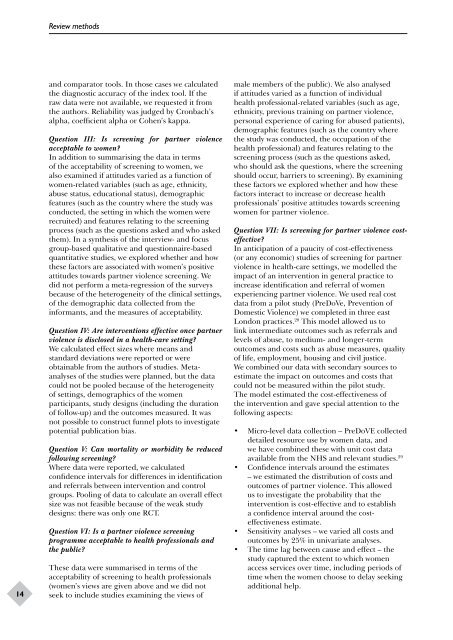How far does screening women for domestic (partner) - NIHR Health ...
How far does screening women for domestic (partner) - NIHR Health ...
How far does screening women for domestic (partner) - NIHR Health ...
Create successful ePaper yourself
Turn your PDF publications into a flip-book with our unique Google optimized e-Paper software.
14<br />
Review methods<br />
and comparator tools. In those cases we calculated<br />
the diagnostic accuracy of the index tool. If the<br />
raw data were not available, we requested it from<br />
the authors. Reliability was judged by Cronbach’s<br />
alpha, coefficient alpha or Cohen’s kappa.<br />
Question III: Is <strong>screening</strong> <strong>for</strong> <strong>partner</strong> violence<br />
acceptable to <strong>women</strong>?<br />
In addition to summarising the data in terms<br />
of the acceptability of <strong>screening</strong> to <strong>women</strong>, we<br />
also examined if attitudes varied as a function of<br />
<strong>women</strong>-related variables (such as age, ethnicity,<br />
abuse status, educational status), demographic<br />
features (such as the country where the study was<br />
conducted, the setting in which the <strong>women</strong> were<br />
recruited) and features relating to the <strong>screening</strong><br />
process (such as the questions asked and who asked<br />
them). In a synthesis of the interview- and focus<br />
group-based qualitative and questionnaire-based<br />
quantitative studies, we explored whether and how<br />
these factors are associated with <strong>women</strong>’s positive<br />
attitudes towards <strong>partner</strong> violence <strong>screening</strong>. We<br />
did not per<strong>for</strong>m a meta-regression of the surveys<br />
because of the heterogeneity of the clinical settings,<br />
of the demographic data collected from the<br />
in<strong>for</strong>mants, and the measures of acceptability.<br />
Question IV: Are interventions effective once <strong>partner</strong><br />
violence is disclosed in a health-care setting?<br />
We calculated effect sizes where means and<br />
standard deviations were reported or were<br />
obtainable from the authors of studies. Metaanalyses<br />
of the studies were planned, but the data<br />
could not be pooled because of the heterogeneity<br />
of settings, demographics of the <strong>women</strong><br />
participants, study designs (including the duration<br />
of follow-up) and the outcomes measured. It was<br />
not possible to construct funnel plots to investigate<br />
potential publication bias.<br />
Question V: Can mortality or morbidity be reduced<br />
following <strong>screening</strong>?<br />
Where data were reported, we calculated<br />
confidence intervals <strong>for</strong> differences in identification<br />
and referrals between intervention and control<br />
groups. Pooling of data to calculate an overall effect<br />
size was not feasible because of the weak study<br />
designs: there was only one RCT.<br />
Question VI: Is a <strong>partner</strong> violence <strong>screening</strong><br />
programme acceptable to health professionals and<br />
the public?<br />
These data were summarised in terms of the<br />
acceptability of <strong>screening</strong> to health professionals<br />
(<strong>women</strong>’s views are given above and we did not<br />
seek to include studies examining the views of<br />
male members of the public). We also analysed<br />
if attitudes varied as a function of individual<br />
health professional-related variables (such as age,<br />
ethnicity, previous training on <strong>partner</strong> violence,<br />
personal experience of caring <strong>for</strong> abused patients),<br />
demographic features (such as the country where<br />
the study was conducted, the occupation of the<br />
health professional) and features relating to the<br />
<strong>screening</strong> process (such as the questions asked,<br />
who should ask the questions, where the <strong>screening</strong><br />
should occur, barriers to <strong>screening</strong>). By examining<br />
these factors we explored whether and how these<br />
factors interact to increase or decrease health<br />
professionals’ positive attitudes towards <strong>screening</strong><br />
<strong>women</strong> <strong>for</strong> <strong>partner</strong> violence.<br />
Question VII: Is <strong>screening</strong> <strong>for</strong> <strong>partner</strong> violence costeffective?<br />
In anticipation of a paucity of cost-effectiveness<br />
(or any economic) studies of <strong>screening</strong> <strong>for</strong> <strong>partner</strong><br />
violence in health-care settings, we modelled the<br />
impact of an intervention in general practice to<br />
increase identification and referral of <strong>women</strong><br />
experiencing <strong>partner</strong> violence. We used real cost<br />
data from a pilot study (PreDoVe, Prevention of<br />
Domestic Violence) we completed in three east<br />
London practices. 28 This model allowed us to<br />
link intermediate outcomes such as referrals and<br />
levels of abuse, to medium- and longer-term<br />
outcomes and costs such as abuse measures, quality<br />
of life, employment, housing and civil justice.<br />
We combined our data with secondary sources to<br />
estimate the impact on outcomes and costs that<br />
could not be measured within the pilot study.<br />
The model estimated the cost-effectiveness of<br />
the intervention and gave special attention to the<br />
following aspects:<br />
• Micro-level data collection – PreDoVE collected<br />
detailed resource use by <strong>women</strong> data, and<br />
we have combined these with unit cost data<br />
available from the NHS and relevant studies. 29<br />
• Confidence intervals around the estimates<br />
– we estimated the distribution of costs and<br />
outcomes of <strong>partner</strong> violence. This allowed<br />
us to investigate the probability that the<br />
intervention is cost-effective and to establish<br />
a confidence interval around the costeffectiveness<br />
estimate.<br />
• Sensitivity analyses – we varied all costs and<br />
outcomes by 25% in univariate analyses.<br />
• The time lag between cause and effect – the<br />
study captured the extent to which <strong>women</strong><br />
access services over time, including periods of<br />
time when the <strong>women</strong> choose to delay seeking<br />
additional help.
















